Being able to catch speckled trout deep is an essential skill of inshore fishing, and can be more challenging than fishing shallow.
Catching speckled trout in shallow water is easy. Doing so allows for a wide margin of error, but catching them deep requires a little more thought and skill.
Should this fail to happen, then you could literally be on top of speckled trout that are actively feeding and never catch them!
In this guide, you and I will explore why deep water is so challenging to begin with, then reveal the best tackle and techniques to help you meet that challenge.
But, if you’re wondering how to find these kinds of fishing spots, then I strongly suggest my previous guide, How To Find Deep Holes for Speckled Trout.
For now, let’s get started by asking the following question:
How deep is “deep” water for speckled trout?
When I say “deep” I mean anywhere from ten to thirty feet. There are times and places you could catch speckled trout deeper than this, but that is rare.
Now, typically when you fish for specks in deep water, they are feeding at the bottom of it.
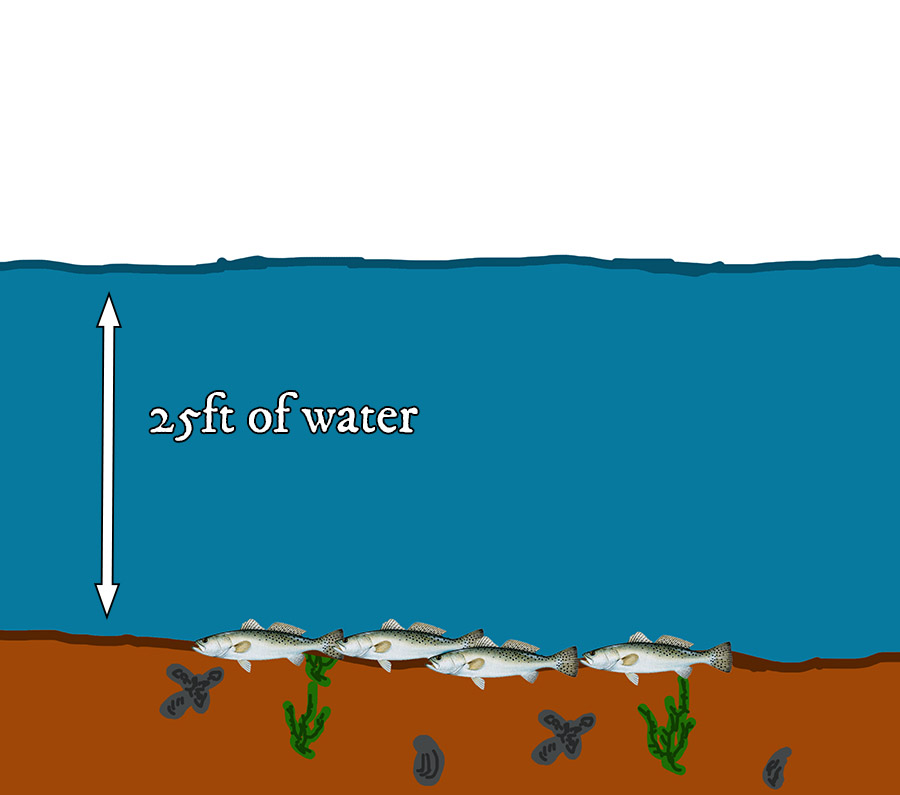
Speckled trout tend to feed at the bottom of the water column, rarely in the middle or the top.
If they fed at the top, then they’d be easier to catch and there would be no deep-water challenge to begin with.
A good example would be this fishing trip in Lake Pontchartrain.
The water was about 12ft deep, but speckled trout were feeding on shrimp at the surface of the water.
What worked best was fishing the top of the water column with a popping cork.
But — if they were at the bottom — then I would have had to fish differently and things would have been a little more difficult, which leads us to this next question:
Why is it so hard to catch speckled trout deep in the first place?
Well, because the only way you’re ever going to catch a speckled trout is by getting your bait in front of her where she can see it.
If she can see it, she can bite it. This is called “getting a good presentation”.
A “bad presentation” would be the opposite, or failing to put the bait where she can see it.
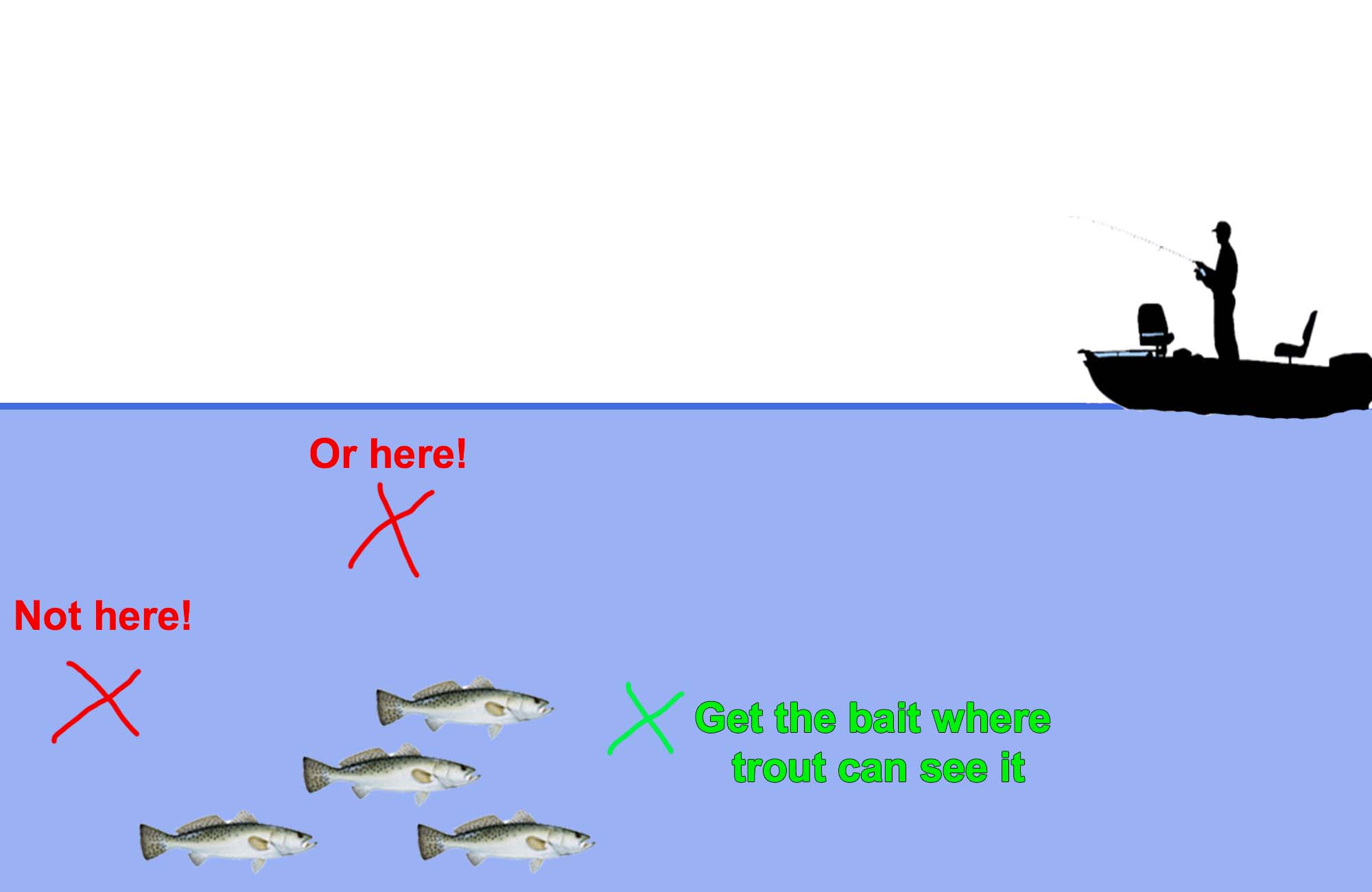
The green X is what "getting a good presentation" looks like.
When you fish shallow with a popping cork — say 2-4ft — you don’t need to consider how your cast and where you are casting affects your presentation. You just know that it’s under the cork by however long your leader is.
But when it comes time to catch speckled trout deep, you would want to cut the cork off and tie on a lure or rig that’s going to sink and, because it sinks, it is a lot more difficult to know where that bait is in the water column.
That’s because when a bait sinks, it does not always do so in a straight line. It could slide in one direction or another.
Did it hit the bottom or is it still falling? Did it land where the fish are or did it glide behind them?
The current could sweep your lure away from where you intended it to go, or it could swing away on the fishing line it’s tied to. The current and wind also push on the fishing line, which is an additional complication.
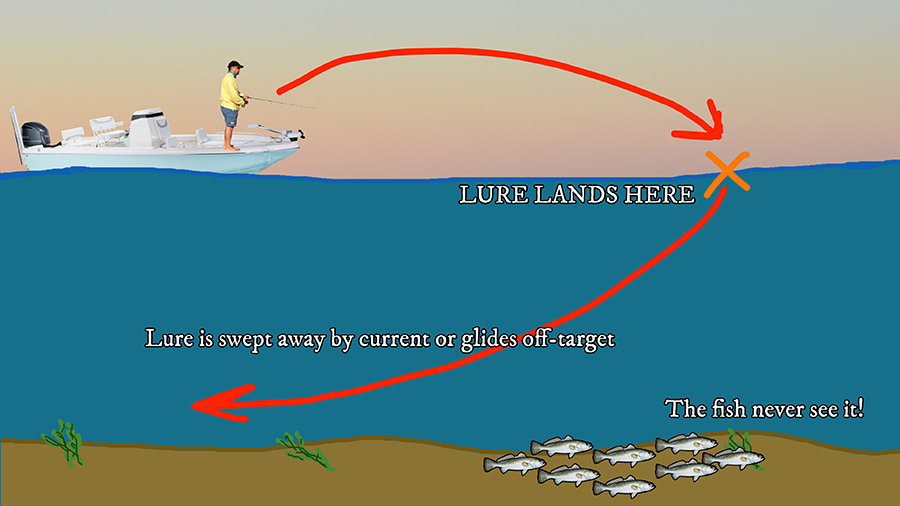
Given these factors, it’s possible that you can be casting to where a school of hungry speckled trout are biting and not catch a single one.
And, if that were to happen, it would be because you failed to get a good presentation on them. They never saw your bait because it went off-target on its way down to the bottom.
This is not unlike target shooting:
It is a lot easier to hit a target that is close, that’s a no-brainer. It’s right there in front of you.
But it’s much harder to hit one that’s farther away because the margin of error is so much wider.
Well, a target that’s close is like fishing shallow and a target that’s far away is like fishing deep.
So how can we be more accurate with our presentations to catch speckled trout deep?
It’s right about now I can jump down the rabbit hole of weight selection, casting tackle, slack line jigging, boat positioning and more.
But I shall resist that temptation and implement the KISS method, or Keep It Simple Stupid, with two things:
We’ll get started with over-weighting.
Over Weighting Your Rig
The concept of over-weighting a rig is simple: you overcome the complications of fishing deep by putting a significantly heavier sinking weight on your lure or rig.
It’s kind of like killing a fly with a shotgun. It’s a little overkill, but it works.
A good example would be a Seabrook Rig, which is essentially a Carolina Rig with a one ounce bank sinker instead of something more traditional, such as a 1/4 ounce or 3/8 ounce egg sinker.
Another good example would be a 1 ounce jighead. It looks kind of silly because it’s so much larger than a 3/8oz or 1/2oz jighead, but believe me, it works.
One of my favorite rigs to catch speckled trout deep is a Heavy Drop Shot, and on this rig I’ll overweight by as much as two ounces, depending on the situation.
The heavier weight works so well because it slices through deep water, reaching the bottom much easier than a lighter weight we’d normally fish with.
The forces mentioned earlier are overcome by the extra sinking weight.
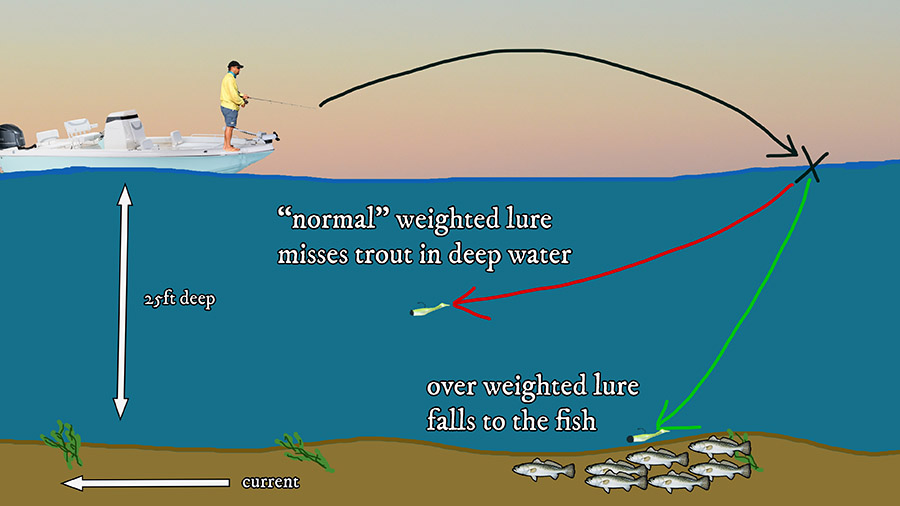
How much sinking weight should you use?
I’d say that if you’re fishing 10-15 feet deep you should use a 1/2oz of sinking weight, and if you’re fishing 15-30 feet deep you should consider 1 ounce or more.
The general rule to use is this: The deeper the water and the more it moves, the heavier you will want to be.
But Don’t Go Too Heavy When Trying To Catch Speckled Trout Deep!
By now you may be thinking, “Well, if one ounce works, then why not five ounces?”
That makes sense, but I’ll tell you why it’s not a good idea to go too far with over-weighting.
First, your rod and fishing line may not be rated for it. If you go too heavy then you need to start changing the rest of your tackle and that will most likely be counter-productive.
Second, depending on what lure or rig you are fishing with, too much sinking weight could cause you to lose fish, as it gives the fish more leverage to throw the hook.
Third, it could cause more snags. A heavier weight finds snags and gets stuck in them much more easily than a lighter weight.
Ultimately, a skilled angler can use less weight to achieve good presentations in deep water, very much in the same way a skilled bowler is able to get more strikes without the use of gutter guards.
So, now that we have over-weighting out of the way, let’s move on to the next thing you can do to catch speckled trout deep:
Changing How You Cast
There is another way to achieve a good presentation on speckled trout in deep water, and that is to change how you cast.
Changing how you send your lure to the bottom of deep water will allow you to get good presentations where normal casting would not.
See, most fishermen are accustomed to casting their lure out, especially when fishing something simple like a popping cork.
They cast it out and away from the boat, because that’s where the fish are: out and away from the boat.
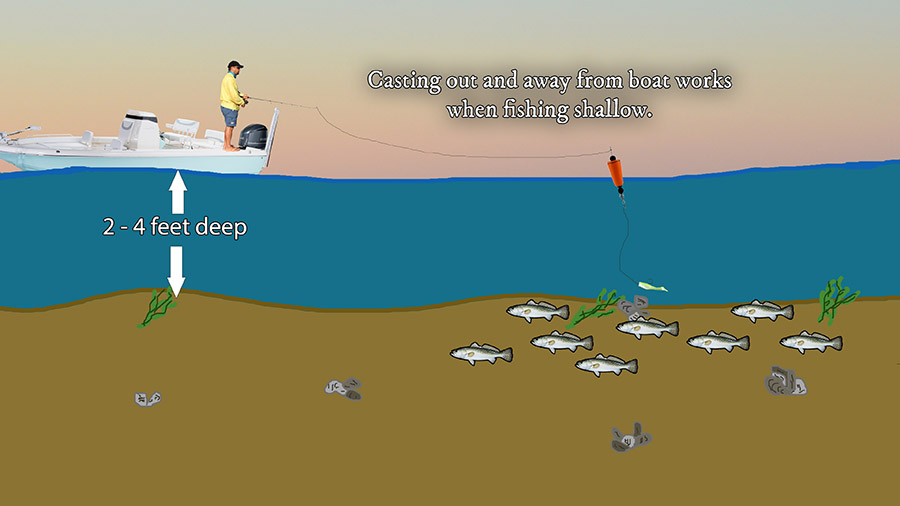
But this style of casting isn’t always the best when you’re trying to catch speckled trout deep.
That’s because you could cast past the fish. This can happen when more fishing line is exposed to the water, putting drag on your lure and not allowing it to fall as well as it could if there were less line in the water.
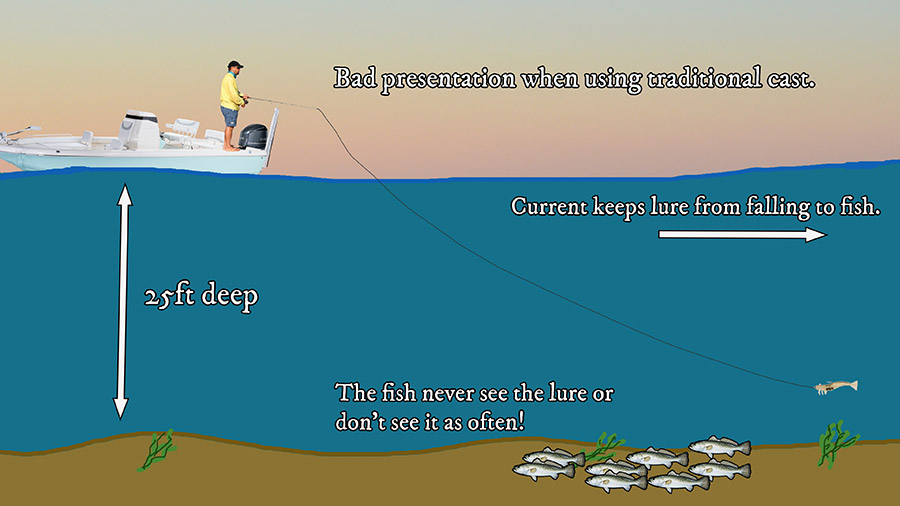
This effect is more pronounced if the water is moving. The stronger the current, the stronger the effect and therefore the more difficult to reach the bottom to get a good presentation.
So, you will want to change how you cast using the Open Bail Method.
Use The Open Bail Method To Catch Speckled Trout Deep
The easiest way to do this is to literally dump your over-weighted rig over the side of the boat on an open bail.
Just let it peel out line so it can fall to the bottom. When the line suddenly stops, then you know you hit the bottom and should close the bail.
It gets to the bottom much easier because there’s less line in the water, creating less drag, and it’s not swinging on a tight line, but falling straight down on a slack line.
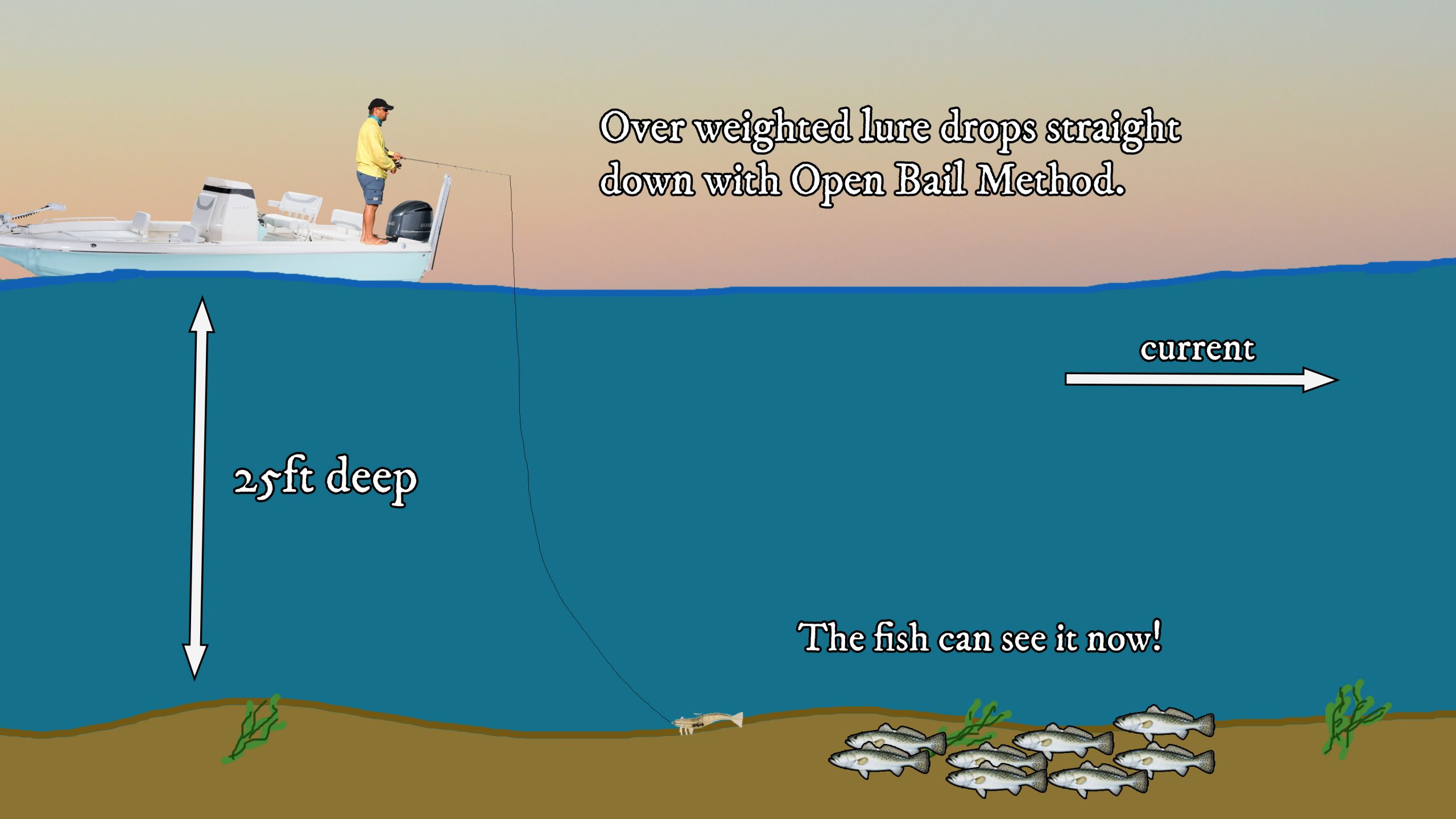
This technique is feasible when trying to catch speckled trout deep, because they could be under the boat!
This is possible — even likely — in deeper water, but rarely the case in shallower water.
If you were fishing shallow, you’d never plop the bait over the side of the boat!
The Disadvantage of The Open Bail Method
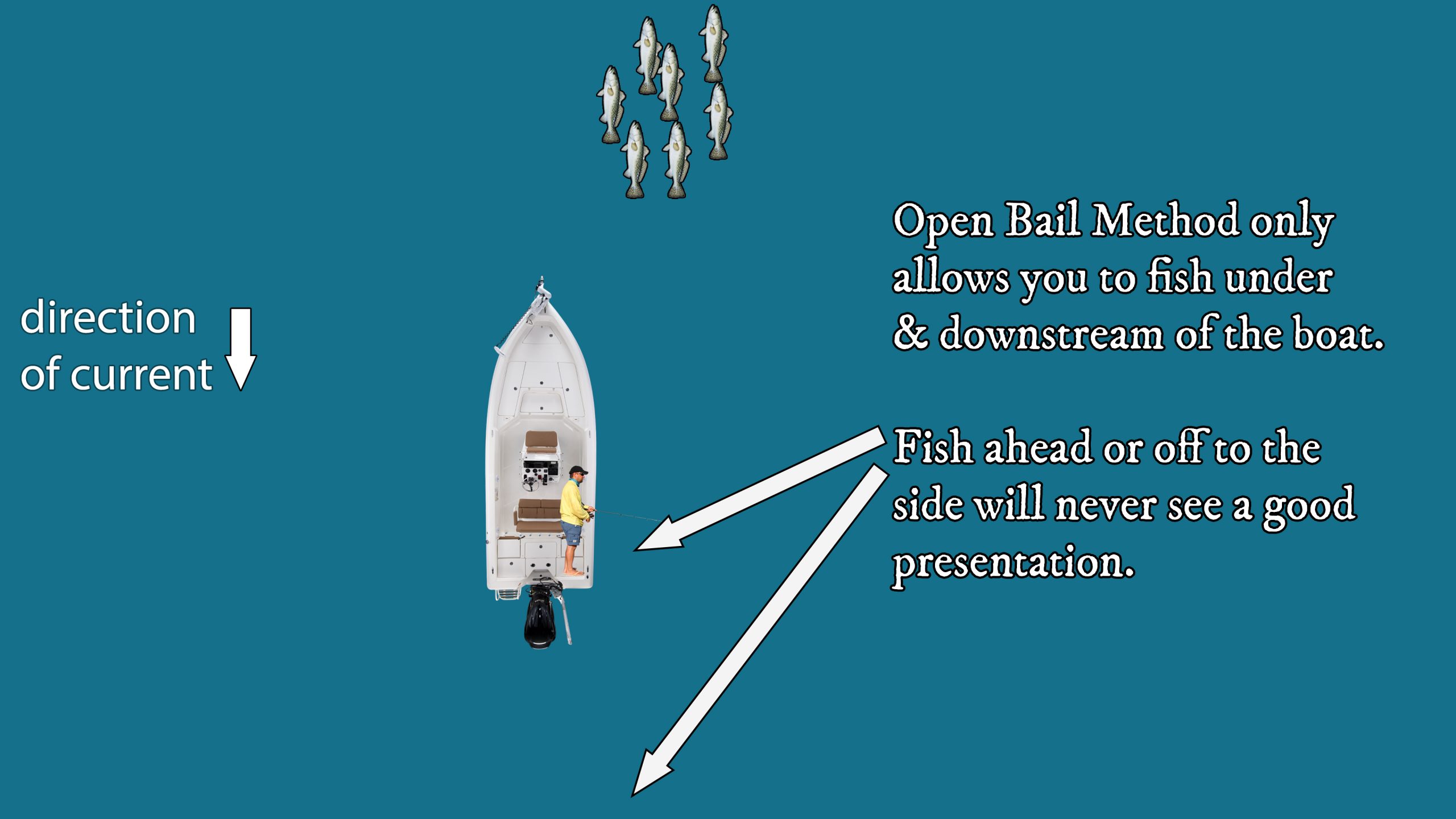
But there is a weakness to fishing with the open-bail method: it only allows you to fish under the boat or downstream of it.
While it is very good at fishing those two spots, it doesn’t enable you to catch catch speckled trout deep that could be holding off to the side of the boat or upstream of it.
The solution to this problem is to cast like you normally would, but with a slight modification to your technique called the Slack Line Method.
Slack Line Method
When people normally cast something like a popping cork, they cast out and close the bail as soon as the cork lands in the water.
Easy peezy.
But what you want to do when fishing deep with an over-weighted rig is to put slack in the line. Do not close the bail once the lure hits the water.
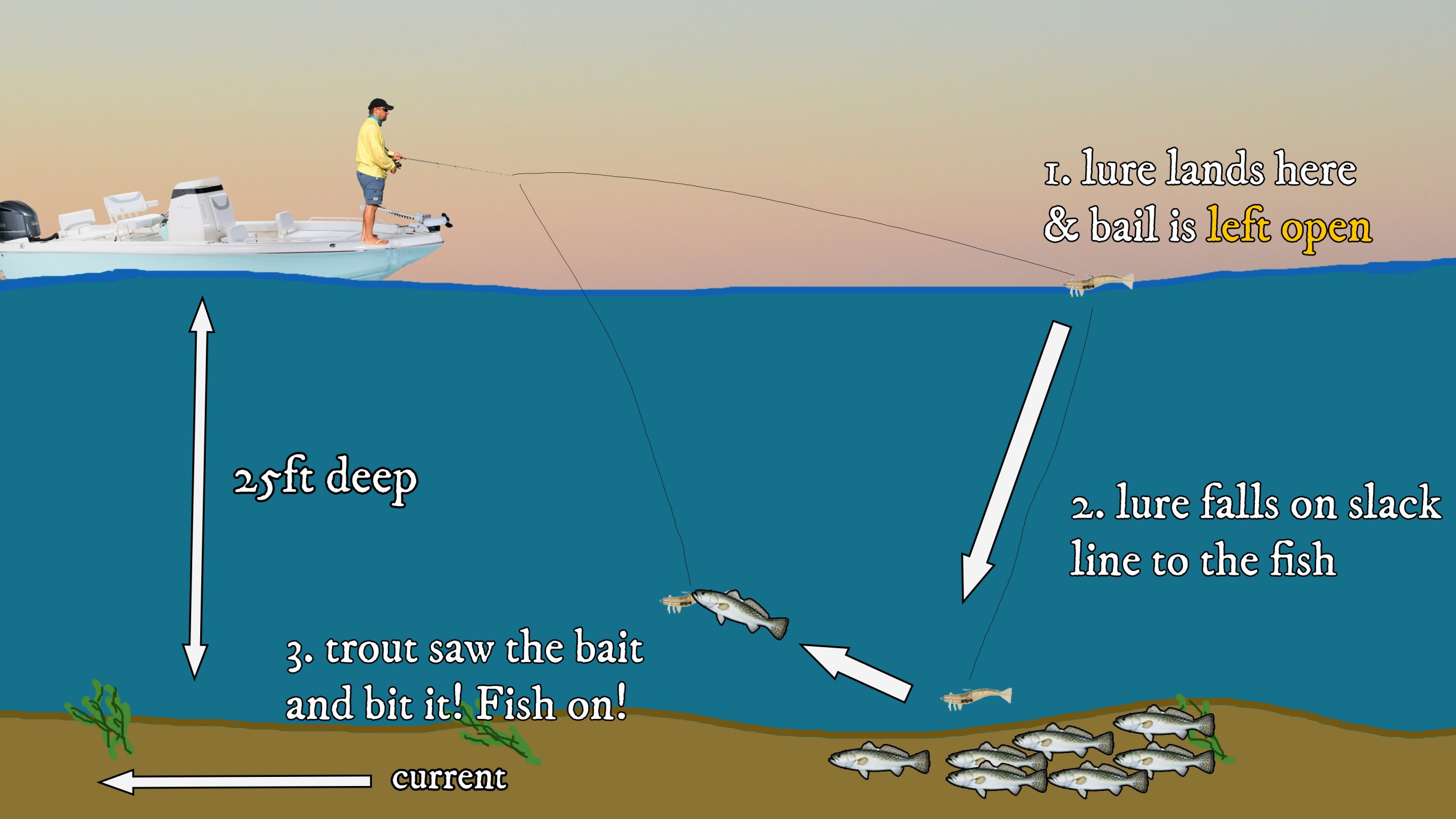
Let it take some slack off the spool. It even helps to lift up on the rod then put it back down to strip out extra line. Then close the bail and let the lure take the slack out of the line.
You’re doing this so the lure can fall straight down to achieve a good presentation instead of swinging back toward the boat and failing to make a good presentation. This is the best way to catch speckled trout deep.
If you closed the bail when the lure hit the water — like you would a popping cork — then the lure would not fall to the bottom. It would instead swing back toward the boat, with the tip of the rod being the axis it is swinging on.
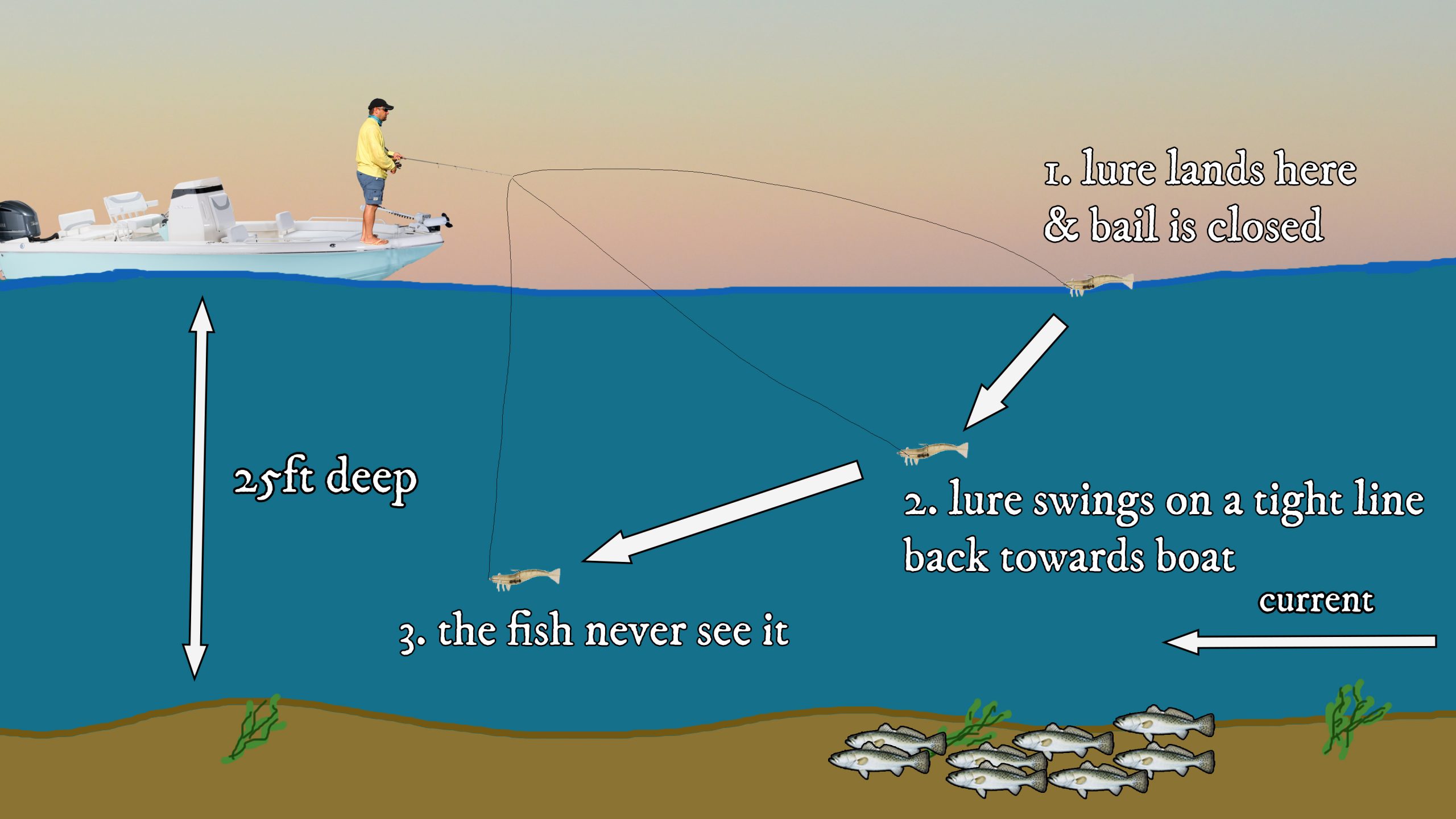
If your cast wasn’t far enough, and if the water was deep enough, then chances are that your bait will never see the bottom where fish are feeding.
The speckled trout literally would never know the bait was there to begin with.
So, if you kept casting the same old way you always have then you could literally cast a hundred times and never catch a fish, even if there are a thousand of them down there.
It won’t matter because you would never get a good presentation on them.
Is it starting to make sense how these small adjustments in tackle and how you cast make all the difference in the world?
Are you seeing what separates the anglers who consistently catch fish from the casual fisherman who gets lucky every once in awhile?
So, if you’re able to change how you cast using the Open Bail and Slack Line Methods, as well as over-weighting your rig, you will be able to catch speckled trout deep much better than others who did not take time to learn this knowledge and skill.
It’s possible that fishing spots that weren’t productive for you before, could suddenly become a new honey hole!
What over-weighted rig could I personally recommend to you?
Throughout this guide I talked a lot about using spinning tackle, and touched on the various rigs you can use to catch speckled trout deep.
But there is one that I really like, and that’s the Heavy Drop Shot.

Thank you for commenting! I always appreciate people who take time to visit my website and love to hear what they think about the content they find here!